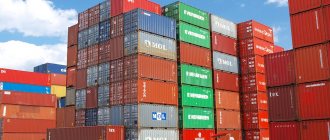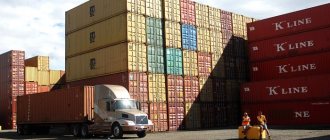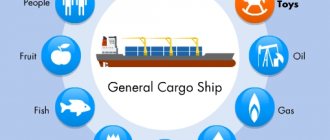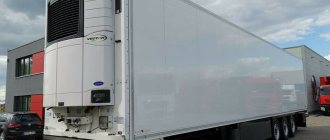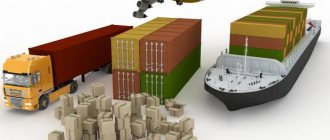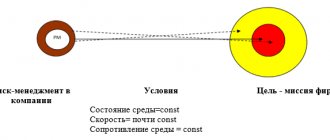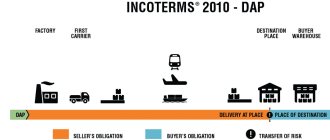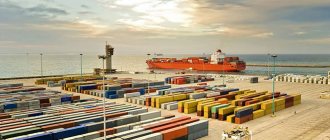Delivery of goods safe and sound is an important condition for trade within the country and abroad. A common way to move goods is using containers. This can be explained by affordable price, convenience, high speed, and no need for overload. Containers are suitable for road, rail, sea and air transportation. They are sealed, reliable, spacious, and most importantly, suitable for repeated use. Used containers often become utility rooms, change houses, storerooms, summer houses, etc.
Advantages of transportation using special containers:
- high degree of cargo protection;
- wide geography of transportation;
- efficiency.
Container transportation is carried out along the optimal route and turns out to be beneficial for the customer. If delivery involves several modes of transport, it is called multimodal. This method is most in demand when transporting over long distances, when there is no direct communication between the point of departure and arrival. You can find out more about container transportation and its directions here.
Prices for transportation in containers
Current prices for cargo delivery to SCH Logistic are presented in the table:
| Sending containers to destinations | 20 ft. | 40 ft. |
| Moscow — Vladivostok | 81500 rub. | 140,000 rub. |
| Moscow — Khabarovsk | 89,000 rub. | 167500 rub. |
| Moscow — Ulan-Ude | 74,000 rub. | 132,000 rub. |
| Moscow — Krasnoyarsk | 50500 rub. | 90200 rub. |
| Moscow — Irkutsk | 62800 rub. | 98200 rub. |
| Prices for all destinations can be found here | ||
Consultation with a specialist Leave your phone number and our specialist will contact you
Container dimensions
Table of characteristics of 3 and 5 ton containers
| 3 t | 5 t | |
| External dimensions, m | 2,1×1,325×2.4 | 2,65×2,1×2,4 |
| Internal dimensions, m | 1,98×1,225×2,38 | 2.52x2x2.15 |
| Doorway, m | 1,22×2,1 | 1,95×2,1 |
| Tara, t | 0,6 | 1,2 |
| Cargo weight, t | 2,4 | 3,8 |
| Gross weight, t | 3 | 5 |
| Volume, cubic m | 4,9 | 10,4 |
Features of container transportation
The purpose of containers is to facilitate the transport of various goods. Today the market offers containers of large, small and medium volumes. Containers are metal frames lined with iron sheets with an anti-corrosion coating. Available container volumes - 20, 40 and 45 feet - are selected individually, depending on the amount of cargo and its type. For large batches and large-sized products, 45-foot modules are chosen. These are the most voluminous modules, which later often become small garden houses, construction sheds, and warehouses.
Among the advantages of container transportation are:
- Safety. The durable module protects transported products from damage, precipitation, strong winds and unauthorized opening. Before dispatch, the container is locked with locking and sealing devices (ZPU) and is opened only upon arrival at the destination, in the presence of the customer. Accompanying documents must be attached to the cargo. When crossing state borders in transit, containers are not opened or checked, as they were checked in advance and sealed. This saves time and financial costs for new packaging.
- Economical. Moving goods in modules over long distances turns out to be more profitable than road transportation in terms of time and money. Another type of savings is the absence of costs for packaging and container production.
- Possibility of delivery anywhere in the world. Thanks to special fastenings, the container is easy to load and unload. To deliver it to its destination, various types of transport can be used: cars, trains, ships, airplanes. This feature allows you to move cargo between points that do not have direct communication.
Container shipping has many advantages, so it is difficult to find an alternative. The only obstacle in choosing this method of cargo delivery is the lack of cargo terminals.
Transportation contract
Concluding a contract for the transportation of household items will save you from unnecessary problems.
Transport company manager:
- assess the volume, specificity, degree of fragility of the transported cargo;
- will tell you which type of transport to prefer;
- will suggest suitable packaging material.
Insurance of the transported cargo is not required, but if the items were insured, then in the event of property damage or other emergency situations, the carrier will compensate for the damage.
Characteristics and types of containers
SCH Logistic offers containers of 20, 40 and 45 feet. The container has standard sizes. Thanks to this, it is easy to transport by various modes of transport: air, rail, water, road.
There are different types of containers, which are divided into categories depending on their characteristics, the most important of which are the size and potential weight of the cargo being transported. If the size of the transported cargo exceeds the dimensions of the container, gondola cars and open platforms are used.
Container characteristics:
- 20-foot modules are used when moving medium-sized loads. In the standard version, the module doors are located at the end, in the non-standard version - on the top or side, sometimes they are double. There are also thermally insulated products intended for the transportation of chilled products and frozen raw materials.
- 40-foot containers are suitable for moving heavy, oversized cargo, including large household appliances and cars. To move products at a given temperature, refrigerated containers are used.
- 45-foot models are the largest, but their dimensions do not exceed established standards. Such containers can be freely transported by conventional cargo trailers.
SCH Logistic offers new and used containers at prices below market prices. Before going on sale, all products are tested; new models, if necessary, undergo a cycle of repair and restoration work.
We have a large selection of containers for cargo transportation.
Navigation
3PL (Third Party Logistics), third party logistics
This term is used when logistics services are purchased by a third party. A company providing services in the 3PL format takes responsibility for the entire complex of transport and logistics operations, including interaction with suppliers and sales, which allows the client to significantly reduce and even abandon their own logistics departments.
BIG BAG
Replacement containers for bulk cargo placed in a container. Used for transporting cargo in bulk containers.
Forklift
A vehicle equipped with power-driven horizontal forks capable of lifting, moving or stacking pallets, containers or swap bodies, the latter two types of load units usually being unloaded. Forklifts with a lifting capacity of up to 2 tons are used for loading and unloading inside the container.
Domestic transportation
Transportation of containers, the starting and ending points of which (as indicated in the corresponding consignment note) are located within Russia.
Train schedule
It serves as the basis for organizing the coordinated movement of trains, unites the work of all divisions of the railway on which the transportation of goods and passengers depends. Traffic schedules are used in all countries of the world with developed freight transportation. Drawing up and monitoring the implementation of schedules is carried out using computers.
Cargo unit
A container or detachable body, as well as a loaded (empty) semi-trailer or road train. In principle, a cargo unit can be any box or package.
Freight shipment
Cargo sent on the basis of a contract of carriage. In railway transport, the following types of shipments are distinguished: carload, small, container, piggyback, route and group.
Shipper
An individual or legal entity who, under the contract of carriage, acts on his own behalf or on behalf of the owner of the cargo or luggage and is indicated in the transportation document.
Consignee
An individual or legal entity authorized to receive cargo or baggage.
TEU
A conventional unit of measurement for the quantitative side of traffic flows or throughput. Equivalent to twenty feet or the size of a 20 foot (6.1 m) ISO container. Thus, one standard 40-foot ISO container is equal to 2 TEU.
TEU (twenty foot equivalent unit)
A unit of quantitative measurement of traffic flows. Fits 20 ft (6.1 m) CPC dimensions. A standard 40-foot CPC equals 2 TEU.
Road record
A document recording the dispatch and delivery of goods during freight transportation, regulating the relationship between the shipper, carrier and consignee.
Unified container transport system
A system adopted in Russia and a number of other countries, which means that cargo transported in a container will go all the way from sender to recipient using several types of transport with a guarantee of integrity and safety. In order for the container transport system to operate, a number of conditions must be met. The most important of them is the availability of a container fleet. Their dimensions and design must be unified, that is, they must be suitable for transportation in railway cars, on trucks and in the holds of ships. In addition, they must be convenient for reloading from one vehicle to another, and in order for a crane to reload them, the containers must have special gripping devices.
Railroad station
Train stopping place. Railway stations are called dividing points because they divide the entire road into sections - sections. Large modern stations contain various structures and devices intended for the normal operation of locomotives and cars - depots, workshops, car washing machines, service points. The transportation of goods also involves sorting and cargo stations, equipped with cargo and container sites with handling equipment and warehouses.
Railway junction
Typically, a railway junction means a large railway point that receives freight and passenger trains and carries out the reorganization of trains. A railway junction is a complex of technologically interconnected marshalling, freight and passenger stations, which has main, connecting, bypass and access roads, with stations, depots and its own sources of electricity. It ensures the passage of transit trains from one line to another, transfers cars between the stations included in its composition and the lines converging in it (there are usually at least three of them in a node).
Loading area
The terminal area where containers are loaded onto and/or unloaded from platforms.
Isothermal container (thermos container)
A special container with insulated walls, doors, floor and roof, which allows you to maintain a constant temperature inside when transporting perishable goods, mainly food.
Import transportation
Container transport associated, as indicated in the relevant consignment note, with imports.
Intermodal transportation
Transportation of cargo in the same cargo unit by several modes of transport, when one of the carriers undertakes to organize the entire transportation of cargo from door to door. Such transportation includes delivery to the recipient's warehouse, which can only be done by road transport.
Gantry crane
A crane or lifting mechanism whose bridge is mounted on supports that move along rails. Gantry cranes are typically used to service open (less often covered) warehouses when moving piece goods, containers and timber, for the installation of prefabricated industrial and civil structures, as well as for servicing hydroelectric power plants and sectional installation in shipbuilding.
Bulk container
A container designed for transportation of bulk cargo without additional containers has openings for loading and unloading bulk cargo in bulk.
Containerization
Use of containers for transportation, delivery and storage of goods.
Container train (block train)
A train that consists of cars loaded with containers belonging to the carrier or other persons heading to one destination. Train length and speed are established by regulations. The train is formed at the departure station and follows without separation along the route and without further redirection of containers.
Container terminal
A place equipped for transshipment and storage of containers. A container terminal usually includes one or more container yards. The railway container terminal is equipped with access roads for loading and unloading containers to/from railway platforms (cars).
Container turnover
The number of containers processed at a port or station from arrival to departure in a given period of time.
Containerable cargo
Goods suitable for transportation in containers, or goods for which a container is the optimal or only possible means of transportation.
Open top container
Container for overhead loading of various cargoes, such as heavy equipment or oversized cargo.
Container transportation
Combined transportation by rail and road transport. In the SMGS system (Agreement on International Freight Transport by Rail), piggyback transportation refers to the transportation by rail of complete loaded road trains, semi-trailers and swap bodies.
Empty run ratio
The average empty travel distance of a platform or container divided by the average total travel distance of a platform or container, respectively.
Large container
A container manufactured to International Organization for Standardization (ISO) specifications and used for the intermodal transport of goods.
Linear ship
A ship that makes voyages between specific ports. Such a vessel may carry containers with different destination ports.
Lo-lo
A vertical method of loading and unloading containers (and, in some cases, semi-trailers and road trains) using lifting equipment.
Logistics
Organization of the delivery chain and management of this chain in the broadest sense. This chain can cover both the supply of raw materials necessary for production and the management of material resources in the enterprise, delivery to warehouses and distribution centers, sorting, processing and final distribution at points of consumption. In the context of transport services, the main thing is the delivery of cargo along the route.
Logistics center
A territorial association of independent companies and organizations involved in cargo transportation (transport intermediaries, shippers, operators and customs authorities), which provides customers with related services (for example, operational storage, maintenance and repair of containers) and includes at least one terminal. The main purpose of logistics centers when transporting goods in containers is to level out the unevenness of container flows at the junctions of two or more modes of transport by assembling container lots for one purpose.
Marking
Signs, drawings, inscriptions and other symbols applied to containers. Allows you to establish a connection between the cargo and the transportation document, distinguish one batch of cargo from another, establishes the procedure for accounting for containers and reports on security measures during transportation.
International commercial terms (Incoterms)
International rules adopted by governments, companies and merchants around the world to interpret the most applicable terms in international trade.
As a rule, Incoterms apply to the individual rights and obligations of the parties regarding the delivery of goods under an international sales contract. Each term is a three-letter abbreviation.
Dangerous goods
Cargo that, if handled incorrectly, can cause damage to property, death or deterioration in human health. Transportation of such goods is carried out in accordance with special transportation conditions.
Operator
A legal entity or individual entrepreneur who owns wagons and containers by right of ownership or other right, participating on the basis of an agreement with the carrier in the implementation of the transportation process using these wagons and containers.
From door to door
Comprehensive logistics service for the delivery of goods directly from the warehouse of the shipper (supplier of the goods) to the warehouse of the consignee (recipient of the goods). As a rule, it includes not only rail transportation and delivery by road, but also terminal processing of cargo, as well as (if necessary) its customs clearance and payment in accordance with INCOTERMS 2000. Appeared in response to the cargo owner’s desire to deal with the only executor of his order.
Transshipment
Moving a container from one type of transport to another.
Carrier
An individual or legal entity who, in accordance with the contract of carriage, has assumed the responsibility for the delivery of a passenger, cargo or luggage by public railway transport from the point of departure to the point of destination, as well as for the delivery of the cargo or luggage to the person authorized to receive it (recipient).
Rotary lock
A standard material handling mechanism that fits into the openings of container corner fittings to secure them to vehicles.
Rolling stock
Freight or passenger cars intended for rail transportation.
Gondola car
A type of rolling stock with a flat bottom and relatively low sides, used to transport materials such as ore or scrap, loaded and unloaded from above. Can be closed or open.
Empty mileage
For containers - transportation of an empty container on a platform, for a platform - mileage without container(s) or any non-container cargo.
Portal crane
An overhead crane with a horizontal portal mounted on supports that are stationary or move along a rail track or on rubber tires. Ensures the movement of goods from vehicles to railways. In Russia, gantry cranes are more often used. Seaports use jib gantry cranes that are installed on shore.
Ramp
Typically an adjustable horizontal or inclined platform that allows vehicles to drive on or off a ship or railroad car. In the terminology of cargo operations of Russian railway transport, the term “ramp” fits this definition, and the term “ramp” means a device at the end cargo fronts (mainly warehouses) built at the same level as the height of the vehicle for the convenience of loading and unloading operations.
Regulation (infrastructure service)
Direction of empty wagons or containers from unloading places to a new loading place.
Reach stacker
A high-power loader designed to work with CPC, capable of handling loads up to 45 tons. Reach stackers can handle containers standing in several rows.
Ro-ro
A horizontal method of loading and unloading vehicles and wagons onto or from a ship on their own wheels.
STK (medium-tonnage container)
A medium-capacity container of an outdated local standard used in Russia and the countries of the former Soviet Union, designed for the transport of goods whose weight does not exceed 5 tons
Through rate, through rate
A single price for a full range of transport and logistics services for the delivery of cargo in a container “from door to door”. The price is set for one container and fixed for a certain period by agreement with the client, subject to the provision of certain minimum volumes of transportation.
Mixed freight train
A train that consists of different types of cars carrying different types of goods, often destined for different destinations.
Sort Facility
A portion of a freight railroad yard used to separate or add cars to a train, or to divide a train into several parts.
Sorting center
A central point for the collection, sorting, transhipment and distribution of goods for a specific region. In the practice of container transportation, JSC Russian Railways is a container point where direct cars loaded with containers are formed. It has the same purpose as a logistics center in large container processing areas and the junction of several modes of transport.
Spreader
An adjustable mechanism on a lifting equipment designed to connect to fittings at the top corners of a container or to connect using a container grip mechanism from the bottom.
Delivery period
The period of time during which the carrier is obliged to deliver the cargo to its destination and for compliance with which he is responsible to the cargo owners. Includes the time required to transport cargo from the point of departure to the point of destination (including loading and unloading operations), performing various auxiliary operations and processing documents. For delays in delivering goods beyond the agreed deadlines, the carrier pays the cargo owner a fine, usually set as a percentage of the freight charge. In the event of emergency situations and force majeure, the carrier is exempt from paying a fine for late delivery of cargo.
Standard carriage
A unit of measurement equivalent to a 14 meter long carriage.
Standard train
A train consisting of 71 standard cars and 1 locomotive.
Stevedore
A legal or natural person who loads and unloads ships. Hired by the shipowner or charterer.
Boom forklift
A pneumatic boom lift designed to move or stack containers on a horizontal, reinforced surface. According to the terminology adopted by JSC Russian Railways, this is a heavy-duty diesel forklift equipped with a spreader or pincer gripper for cargo operations with semi-trailers for piggyback transportation.
Dry port
The term exists only in French and English and refers to an inland terminal that is directly connected to a seaport. In Russia, a dry port usually means either a port station or a container terminal, which, through the port station, forms container shipments to the port.
Time charter
Shipping services provided by hiring a vessel for a specified period of time for a fee called freight, usually based on a monthly rate per deadweight ton or a daily rate. During the agreed period, the charterer has the right to use the ship as he sees fit, but the shipowner continues to operate his ship through the captain and crew who remain on board.
Tank container (tank container)
A container that consists of two main elements: one or more tanks and a frame that meet the requirements of the international standard ISO 1496-3.
Terminal
A place equipped for transshipment and storage of containers. At JSC Russian Railways, the terminal is more often called a “container site” or “container terminal”.
Thermos container or insulated container
A 20- or 40-foot insulated-lined container that does not include cooling and/or heating devices.
Transit
Transportation of goods from one country to another through the territory of third countries. The issue of allowing transit and its conditions is the subject of trade treaties and agreements between individual countries. A distinction is made between direct transit, when the transportation of foreign goods is carried out under customs security without being placed in a customs warehouse, and indirect, when goods arrive at customs warehouses and then abroad.
Angle fitting
A special standard device, which is a mandatory element of the container design, intended for securing containers to vehicles during transportation or among themselves. Typically located in the top and bottom corners of the container. Twist locks or other devices are introduced there to allow the container to be lifted, stacked or secured. Recently also used on swap bodies. At the same time, detachable bodies and containers of the new generation with a length not divisible by 20 feet (for example, 45 feet) in addition to corner fittings also have an additional set of fittings, the spatial lattice of which corresponds to the lattice of 20 and 40-foot containers. This makes it possible to use the same means of transportation and loading and unloading equipment when operating them.
Extended (long-wheelbase) fitting platform
Fitting platform designed to transport four TEUs.
Containerization level (or ratio)
For a certain type of goods, means the volume of goods transported in containers, as a percentage of the total volume of such goods transported; for a region or mode of transport (for example, by rail) means the ratio of the tonnage of goods actually transported in containers to the total tonnage of goods that could potentially be transported in containers (containerable cargo).
Feeder transportation
Sea transport over a short distance between two or more ports for the purpose of grouping or distributing cargo (usually containers) at one of those ports for onward transport on the high seas or after such transport.
Feeder vessel
Small vessels capable of sailing at relatively shallow depths. They are used for collecting containers along the vessel’s own route with subsequent transshipment onto liner ships or for unloading containers from liner ships for subsequent transportation along shorter routes.
Fitting
The fitting is a mandatory element of the container design, a standard device for fastening containers to vehicles or to each other. Fittings are typically located at the top and bottom corners of the container where twist locks or other devices are inserted to allow the container to be lifted, stacked or secured.
Containers whose length is not a multiple of 20 feet (for example, 45-foot containers), in addition to corner ones, also have an additional set of fittings, the spatial lattice of which corresponds to the lattice of 20- and 40-foot containers. This makes it possible to use the same means of transportation and loading and unloading equipment when operating them.
Fitting platform
A specialized type of rolling stock designed for CPC transportation.
<check the use of this term by bulk cargo operators>.
Flexitank
Flexible polymer container with a volume of up to 24,000 liters, designed for transporting liquid cargo in a 20-foot container.
Freight
A form of payment for the carriage of goods by sea or the use of a vessel for a certain period of time. Freight payment is determined by the volume of cargo delivered to the destination, or by the amount of cargo taken on board.
Stacker
A tractor-trailer equipped with a front-mounted mechanism for stacking or moving containers. It is mainly used at terminals in seaports. It may also be in demand in the work of logistics or sorting centers.
Stacking
Placing containers on top of each other during storage or transportation.
Forwarder
A person who performs or organizes the performance of freight forwarding services specified in a contract, namely: services for organizing the transportation of goods, concluding contracts for the carriage of goods, ensuring the loading and delivery of goods, etc.
Export transportation
Container transport associated, as indicated in the relevant consignment note, with export.
Delivery methods
Container transportation is carried out by various types of transport and are:
Marine. Many cargoes can be transported by sea, including fragile, hard, and flammable ones. Such delivery has a low cost and is suitable for transporting large quantities of goods.
Automotive. There are international and domestic. Such transportation has a relatively low cost.
Railway. Transportation of this type is considered the most reliable, accurate (time of departure and arrival of cargo at destination). You can find out where the cargo is at a particular moment in time using the train schedule. The only disadvantage of this method of transporting goods is the limited length of railways.
Air. This method of delivering goods is the fastest and safest. It is used for transporting art objects and dangerous goods (in accordance with existing requirements). The main advantage of air transportation is high speed. This method allows you to deliver goods anywhere in the world in the shortest possible time. The only disadvantage of such delivery is the high cost.
Multimodal. The cargo is delivered to its destination by various types of transport, one by one. This type of delivery is in demand mainly for international transport and allows you to optimize the delivery of goods.
Transportation by rail
If transporting containers by sea, especially over long distances, is associated with some risks, then container transport by rail has a reputation as the safest and most reliable. The railway operates strict schedules and the delivery algorithm is worked out to the smallest detail.
- Products are loaded into a container at the supplier's warehouse or production workshop;
- The container is sealed by the sender and delivered to the railway truck;
- Moves to the railway platform and takes its place in the emerging railway train.
At the point of arrival, the sealed container is reloaded onto a truck and delivered “to the buyer’s door”. Following a schedule of freight trains allows you to plan the arrival time of cargo and track its location during transportation.
What is transported in containers?
Container shipping is suitable for transporting various goods. But there are also limitations. Thus, radioactive material, precious stones, jewelry, alcoholic beverages, medical equipment and a number of other goods cannot be transported by road or air without a special license and permit.
There are restrictions on rail transportation for chemical explosives, pyrotechnics and other goods. This method is not suitable for transporting fragile products that can be damaged by the slightest vibration.
Food products with a short shelf life, as well as cargo that exceeds the size of the pallets on which they are installed, are not suitable for sea container transportation.
Detailed, up-to-date information about the possibilities of transporting goods in one way or another is determined at the legislative level.
Existing restrictions
Due to the need to use loading and unloading equipment to move containers from a vehicle to a sea vessel or railway platform, they are subject to special requirements:
- 20-foot containers should be loaded with no more than 22 tons;
- 40-foot - no more than 24 tons.
- deviation of the center of gravity of the cargo – no more than 600 mm for a 20-foot container;
- no more than 1200 mm - in relation to the geometric center of a 40-foot container.
Containers that do not meet the requirements of the Russian Maritime Register of Shipping, as well as those that have rust or other damage that jeopardizes the safety of the cargo, are not allowed for transportation by sea.
There are also restrictions on transported goods. For example, the transport of certain goods requires special permits or licenses. This requirement applies:
- to any dangerous substances;
- medical equipment containing radioactive elements;
- alcohol, narcotic, psychotropic products;
- space or military technology;
- animals, amphibians, birds;
- precious stones, precious metals and products made from them.
Food products also require special transportation conditions. Transporting frozen foods in regular shipping containers is prohibited.
By entrusting the transportation of your cargo, you can rest assured that we strictly comply with the rules of container transportation. We will place your goods in the most suitable container unit, provide sealing, insurance, safe delivery and customs clearance. And all this will be done with your minimal participation.
Directions of container transportation
At SCH Logistic you can order container transportation throughout Russia and beyond: to the CIS countries and neighboring countries. With the ability to constantly monitor cargo transportation, our clients can independently track the location of transport online.
Additional services of our company:
- acceptance of containers, clearance;
- cargo insurance;
- door to door delivery;
- customs clearance of documents;
- responsible storage.
Advantages and disadvantages
Multimodal transportation (involving the use of several modes of transport) has undeniable advantages in the delivery of goods. They are helping:
- Reduce packaging costs, because containers can transport goods without additional packaging, containers, or choose a lightweight packaging option.
- Optimize loading/unloading, reducing time and additional work.
- Significantly reduce the need for warehouse space, because the cargo in containers is reliably protected.
- Reduce transportation costs.
- Safety of goods during transportation.
- Optimize the process of preparing accompanying documentation provided for by the rules.
- Computerize cargo accounting and processing.
In order to organize cargo container transportation, large financial investments are required. This is to create special terminals, purchase transport, loading and unloading mechanisms. But in the future, this reduces costs by 2.5 times, since the entire process is mechanized, delivery becomes faster, and the possibility of damage to goods is eliminated.
Freight multimodal container transportation requires maintenance and repair of the container itself.
Clear information support is required at all stages of transportation. This is due to the fact that the documents may not keep up with the movement or the transport will be forced to wait, which will certainly affect the cost for the carrier company.
Transporting goods in containers is associated with the problem of return. In the opposite direction, transportation is carried out without goods, which reduces the profitability of container logistics.
Prices for container transportation
Container transportation does not have a fixed price. Delivery cost depends on:
- transportation distance (across Russia, to CIS countries or neighboring countries);
- volume of cargo, its geometric parameters;
- complexity of the route (this also includes the number of container reloads, the number of mandatory stops, marshalling stations);
- presence of a forwarder, security;
- the need for special permits.
You can get more information here.
Advantages of contacting our company
Our company has been successfully operating since 2013, which is confirmed by state licenses and positive customer reviews. Cooperation with us relieves clients from studying information about container transportation, resolving issues with customs and other tasks.
We independently prepare documentation for the transportation of goods in accordance with the law. Logisticians select optimal routes for clients that are suitable in terms of price and timing.
Cargo transportation begins and ends exactly on time. For large volumes of transported goods, we reduce delivery costs and provide deferred payment. You can get answers to your questions by phone in Moscow.
